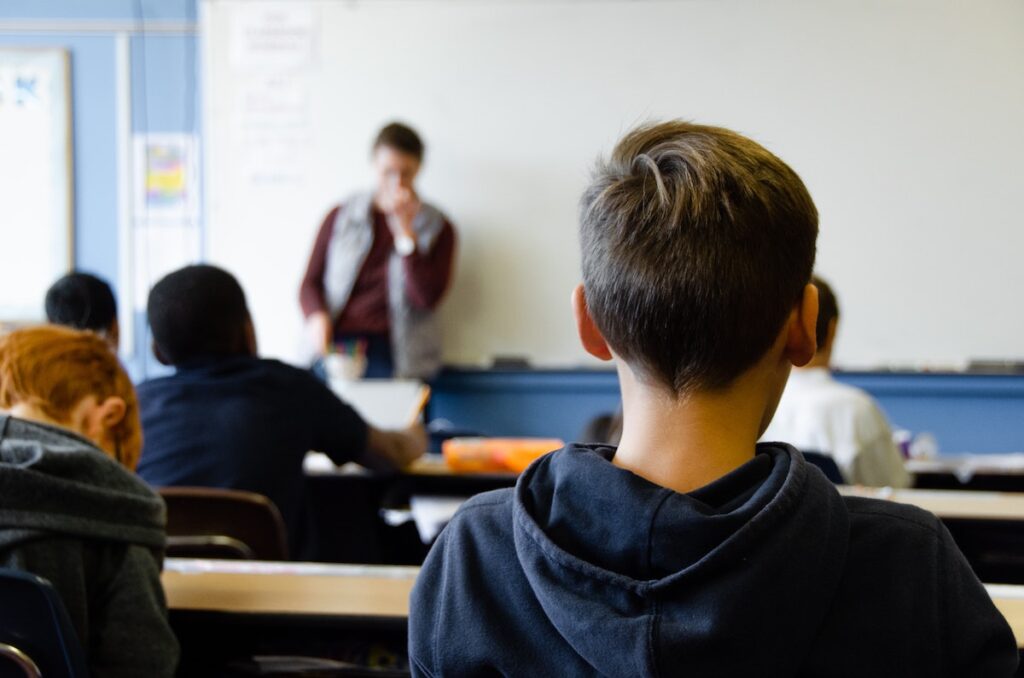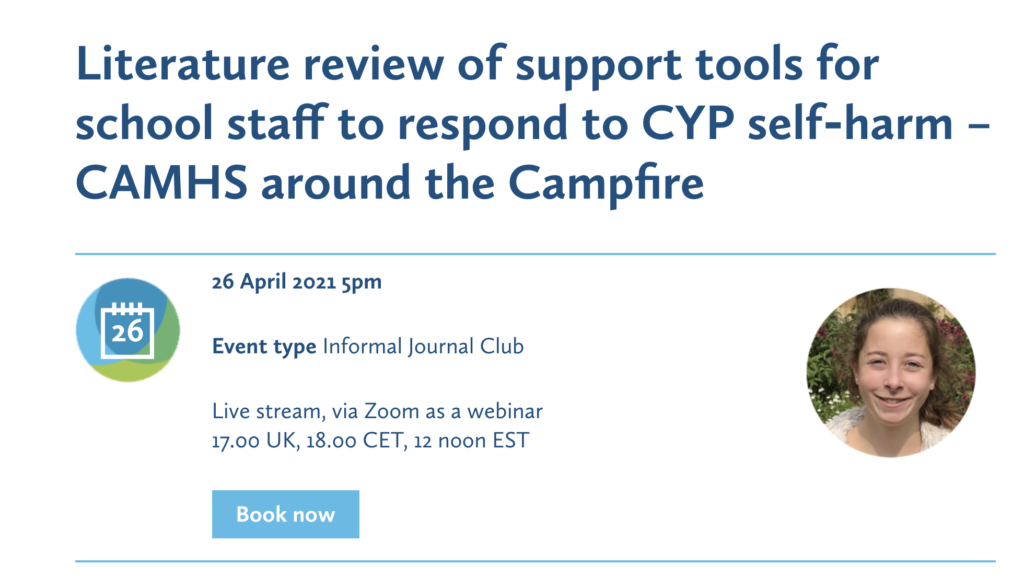
Self-harm has a high prevalence amongst young people, and a high correlation with other adverse health outcomes. It’s a topic we regularly cover in the woodland, so check out our other blogs on self-harm in young people if you want to keep up to date with lots of recent research.
School staff may be the first adults to become aware of potential self-harm behaviour. However, students may not wish to disclose self-harm to school staff, and the staff may be unsure how to respond. Schools have a potential role in early detection, but may also harbour potential triggers for pupils.
So, can we improve the support offered to pupils by making schools better at dealing with young people who self harm?
A recent review (Pierret et al, 2020) looked at the effectiveness of educational and training interventions for school staff. They also took in studies of management and support tools. The reviewers were interested in what these studies could tell us about the effectiveness, feasibility and acceptability of these interventions.
Research question: In schools, does staff training or management support improve staff knowledge, confidence and handling of young people who self-harm?

In schools, does staff training or management support improve staff knowledge, confidence and handling of young people who self-harm?
Methods
The reviewers searched a broad range of bibliographic databases, encompassing health care, social science and educational sources.
They looked for empirical studies (RCTs, quasi-randomised, before-and-after and prospective cohort studies) that investigated the impact of educational, training or other support interventions on staff knowledge of, confidence in and response to self-harm. They also planned to include any qualitative data reported by the studies.
Study selection was partially checked by independent reviewers. Quality rating was by the Effective Public Health Project Practice (EPHPP) Quality Assessment Tool for Quantitative Studies. The protocol is available in PROSPERO.
Results
Eight studies were included in the review with participant numbers ranging from 10 to 400. Six studies looked at staff training and two looked at management and support tools. Most included school counsellors and school psychologists in the staff groups trained.
Meta-analysis could not be conducted because the studies were too different from one another to be combined. A wide variety of interventions was reported: websites, face-to-face training and a “whole school initiative”. Some were designed specifically for the needs of a commissioning organisation. All the studies measured their outcomes differently.
Table of studies
MHPs = Mental health professionals (i.e. counsellors, nurse specialists, psychiatrists or psychologists).
| Study | N | Population | Intervention | Outcome | Findings |
| Berger 2015
Australia |
48 | Teachers, MHPs, support & leaders | Policy addressing self-injury (SI). | Self-reports of quality, acceptability | The policy was relevant and acceptable. |
| Dorko 2010
USA |
25 | MHPs, teachers, nurses, support | Website with information and sources about SI. | Self-reports of knowledge and comfort re: SI | Useful information that improved knowledge. |
| Glennon 2020
USA |
94 | MHPs, nurses | Training session with handouts | Pre- and post-questionnaires | Statistically significant increase in knowledge. |
| Groschwitz 2017
Germany |
236 | Teachers, social workers, MHPs | Workshop on SI, including video and role-play. | Knowledge, confidence and behaviour measures; pre- and post-intervention; 6 month follow-up | Increase in perceived and actual knowledge; sustained improvement in confidence. |
| Lee 2016
UK |
10 | School pastoral staff | Training workshop. | Pre- and post- knowledge questionnaires; semi-structured interviews | Increase in knowledge; the training created a safe space for discussing self-harm. |
| Price 2015
USA |
32 | MHPs, nurses | Workshop in 2 parts: what SI is and how to manage it. | Pre-and post questionnaires on knowledge, confidence and self-efficacy | Increase in knowledge, possibly sustained after 6mo (very small sample size). |
| Robinson 2008
Australia |
213 | MHPs, teachers, support staff | Training over 2 days: what SI is and how to manage it. Handbook and CD-ROM provided. | Questionnaire, pre-, post- and at 6mo. | Improved knowledge, confidence and perceived skill; some evidence of skill retention. Participants with lower skills at baseline improved the most. |
| Townsend 2018
Australia |
400 | Teachers | Whole school initiative in 2 modules. | Knowledge, attitudes and confidence in SI | Improved knowledge, confidence and skills; additional support needed in assessment and referral. |
Quantitative findings
- All eight studies reported an improvement in staff knowledge of self-harm. However, only five tested the statistical significance of the result.
- Three studies repeated their measures after a follow-up period (three to 6 months). They found some indications that knowledge benefits were lost over time.
- However, all studies reported an increase in confidence that seems to be sustained over a longer term.
- Broadly, the interventions improved empathy and attitudes towards young people who self-harm. However, none of the studies looked at the actual subsequent behaviours of staff towards pupils exhibiting these behaviours.
Qualitative findings
The reviewers also looked at qualitative data from the studies. The qualitative findings were grouped into themes:
- The need to equip staff to respond (knowledge and understanding; having a policy in place)
- Interventions need to be tailored to staff background and experience
- Sharing responsibility and working together across professions.

This review found that all school staff training or management support improved empathy and attitudes towards young people who self-harm, but none of the studies looked at the actual subsequent behaviours of staff towards pupils.
Conclusions
Educational interventions may be effective in improving staff knowledge and handling of self-harm in schools.
Further research is needed to quantify the effects of these interventions. We should also look for qualitative evidence to understand the barriers to implementation, and how to tailor them to specific settings.

Educational interventions may be effective in improving staff knowledge and handling of self-harm in schools, but more research is needed.
Strengths and limitations
The key limitations of this review are:
- The quality of the included studies (small sample sizes, high risk of bias)
- The differences between studies (meaning we can’t combine their findings)
- The difference between a school psychologist versus a teacher is not accounted for.
Only three studies tested the statistical significance of their findings, so we can’t regard the null hypothesis as disproven. The observed findings may have been down to conscious or unconscious selection bias, reporting bias or other biases arising from lack of blinding. All studies were rated as being of moderate risk of bias or worse.
It is likely that any negative studies on this question would remain unpublished. Nobody wants to hear about a failed training session, never mind confess in print to having run one! The review may therefore be affected by publication bias. Without quantitative findings, it’s not possible to explore this using funnel plots.
It is likely that a substantial grey literature exists in this field. For example, there is a lot of expertise and experience in the third sector that may not be reported in the research literature. Efforts should be made to identify, carry out and report evaluations of their effects.

It’s likely that a substantial grey literature exists in this field, e.g. expertise and experience in the third sector that may not be reported in the published research literature.
Implications
The reviewers recommend some helpful priorities regarding feasibility and implementation, specifically creating clear policies, flowcharts and processes to support staff in helping young people who self-harm.
However, in order to clearly establish the effects of training interventions in schools to improve the care of young people who self-harm, we need to see:
- Real world randomised trials to quantify the effects of the interventions
- Validated outcome measures so we can assess the effects reliably
- Objective and person-centred outcome measures
- Evaluations of unpublished interventions so that we can learn the lessons from other sectors.

If schools are going to improve their care of young people who self-harm, we need real world randomised trials to quantify the effects of the interventions, validated outcome measures so we can assess the effects reliably, objective and person-centred outcome measures, and evaluations of unpublished interventions so that we can learn the lessons from other sectors.
Conflicts of interest
None.
#CAMHScampfire
Join us around the campfire to discuss this paper
The elves are organising an online journal club to discuss this paper with the authors Lili Pierret and Dr Jo Anderson, an independent expert (Dr Mina Fazel), a young person and our good friends at ACAMH (the Association of Child and Adolescent Mental Health). We will discuss the research and its implications. The webinar will be facilitated by André Tomlin (@Mental_Elf).
The focus will be on critical appraisal of the research and implications for practice. Primarily targeted at CAMHS practitioners, and researchers, ‘CAMHS around the Campfire’ will be publicly accessible, free to attend, and relevant to a wider audience.
It’s taking place at 5-6pm BST on Monday 26th April and you can sign up for free on the ACAMH website or follow the conversation at #CAMHScampfire. See you there!
Links
Primary paper
Pierret ACS, Anderson JK, Ford TJ, Burn A-M. (2020) Review: Education and training interventions, and support tools for school staff to adequately respond to young people who disclose self-harm – a systematic literature review of effectiveness, feasibility and acceptability. Child and Adolescent Mental Health 2020, doi:10.1111/camh.12436.
Other references
Townsend, M.L., Gray, A.S., Lancaster, T.M. et al. A whole of school intervention for personality disorder and self-harm in youth: a pilot study of changes in teachers’ attitudes, knowledge and skills. bord personal disord emot dysregul 5, 17 (2018). https://doi.org/10.1186/s40479-018-0094-8
Effective Public Health Project Practice (EPHPP) Quality Assessment Tool for Quantitative Studies
CASP checklist
| Question | Yes | Can’t tell | No |
| 1. Did the review address a clearly focused question?
|
X | ||
| 2. Did the authors look for the right type of papers?
|
X | ||
| 3. Do you think all the important, relevant studies were included? | X | ||
| 4. Did the review’s authors do enough to assess the quality of the included studies? | X | ||
| 5. If the results of studies have been combined, was it reasonable to do so? | X | ||
| 6. What are the overall results of the review?
|
Broadly favourable; process outcomes; size of the effect not reported. | ||
| 7. How precise are the results?
|
Not applicable | ||
| 8. Can the results be applied to the local population?
|
X | ||
| 9. Were all the important outcomes considered?
|
X | ||
| 10. Are the benefits and harms worth the costs?
|
X | ||
Photo credits
- Photo by Tamanna Rumee on Unsplash
- Photo by Taylor Wilcox on Unsplash

